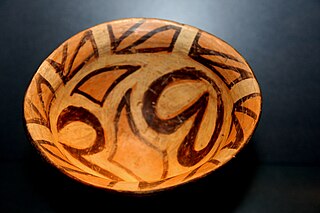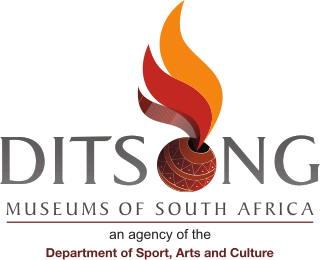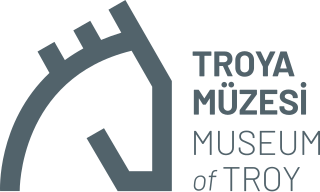
Pretoria, is South Africa's administrative capital, serving as the seat of the executive branch of government, and as the host to all foreign embassies to South Africa.

The Ditsong National Museum of Natural History, formerly the Transvaal Museum, is a natural history museum situated in Pretoria, South Africa. It is located on Paul Kruger Street, between Visagie and Minnaar Streets, opposite the Pretoria City Hall. The museum was established in 1895 by the former South African Republic, also known as the Transvaal. In 2010 it was one of the founding museums of Ditsong Museums of South Africa.

The Cucuteni–Trypillia culture, also known as the Cucuteni culture, Trypillia culture or Tripolye culture is a Neolithic–Chalcolithic archaeological culture of Southeast Europe. It extended from the Carpathian Mountains to the Dniester and Dnieper regions, centered on modern-day Moldova and covering substantial parts of western Ukraine and northeastern Romania, encompassing an area of 350,000 km2 (140,000 sq mi), with a diameter of 500 km.

The National Museum of Iran is located in Tehran, Iran. It is an institution formed of two museums; the Museum of Ancient Iran and the Museum of the Islamic Era, which were opened in 1937 and 1972, respectively. The institution hosts historical monuments dating back through preserved ancient and medieval Iranian antiquities. It also includes a number of research departments, categorized by different historical periods and archaeological topics. National Museum of Iran is the world's most important museum in terms of preservation, display and research of archaeological collections of Iran, and currently displays works that express the richness of history, culture, civilization, art, economic growth and technological achievements of Iran.
The Kingdom of Mapungubwe was a medieval state in South Africa located at the confluence of the Shashe and Limpopo rivers, south of Great Zimbabwe. The name is derived from a dialect of Shona or Venda but there is a possibility it comes from Kalanga The name might mean "Hill of Jackals" or "stone monuments". The kingdom was the first stage in a development that would culminate in the creation of the Kingdom of Zimbabwe in the 13th century, and with gold trading links to Rhapta and Kilwa Kisiwani on the African east coast. The Kingdom of Mapungubwe lasted about 140 years, and at its height the capital's population was about 5000 people.

The Mapungubwe Collection, held by the University of Pretoria museums in its Old Arts Building, consists of archaeological materials excavated by the former University of Gauteng from the Mapungubwe archaeological site since its discovery in 1933. The collection includes ceramics, metals, trade glass beads, indigenous beads, clay figurines, and artifacts made from bone and ivory, alongside a research collection of potsherds, faunal remains, and other fragmentary materials. In June 2000, the University of Gauteng inaugurated the permanent museum. The collection is maintained on site, serving both educational and tourism purposes.

Vinča-Belo Brdo is an archaeological site in Vinča, a suburb of Belgrade, Serbia. The tell of Belo Brdo is almost entirely made up of the remains of human settlement, and was occupied several times from the Early Neolithic through to the Middle Ages. The most substantial archaeological deposits are from the Neolithic-Chalcolithic Vinča culture, of which Vinča-Belo Brdo is the type site.

Prehistoric Thailand may be traced back as far as 1,000,000 years ago from the fossils and stone tools found in northern and western Thailand. At an archaeological site in Lampang, northern Thailand Homo erectus fossils, Lampang Man, dating back 1,000,000 – 500,000 years, have been discovered. Stone tools have been widely found in Kanchanaburi, Ubon Ratchathani, Nakhon Si Thammarat, and Lopburi. Prehistoric cave paintings have also been found in these regions, dating back 10,000 years.

The Bern Historical Museum is the second largest historical museum in Switzerland. It was designed by the Neuchâtel architect André Lambert and built in 1894. Since it was initially conceived as the Swiss National Museum, the architect took as his model various historic castles from the 15th and 16th centuries. An extension to the original museum building was completed in 2009.

The South African National Museum of Military History in Johannesburg was officially opened by Prime Minister Jan Smuts on 29 August 1947 to preserve the history of South Africa's involvement in the Second World War. In 1975, the museum was renamed from the South African National War Museum and its function changed to include all conflicts that South Africa has been involved in. In 1999 it was amalgamated with the Pretoria-based Transvaal Museum and National Cultural History Museum to form the Northern Flagship Institution. In April 2010 Ditsong was officially renamed Ditsong Museums of South Africa and the SANMMH was renamed the Ditsong National Museum of Military History.

Prehistory, also called pre-literary history, is the period of human history between the first known use of stone tools by hominins c. 3.3 million years ago and the beginning of recorded history with the invention of writing systems. The use of symbols, marks, and images appears very early among humans, but the earliest known writing systems appeared c. 5,200 years ago. It took thousands of years for writing systems to be widely adopted, with writing having spread to almost all cultures by the 19th century. The end of prehistory therefore came at different times in different places, and the term is less often used in discussing societies where prehistory ended relatively recently.

The University of Pretoria is a multi-campus public research university in Pretoria, the administrative and de facto capital of South Africa. The university was established in 1908 as the Pretoria campus of the Johannesburg-based Transvaal University College and is the fourth South African institution in continuous operation to be awarded university status. The university has grown from the original 32 students in a single late Victorian house to approximately 53,000 in 2019. The university was built on seven suburban campuses on 1,190 hectares.

Fanie Eloff, (1885-1947) Stephanus Johannes Paulus Eloff was born as the sixth child and second son of Frederik Christoffel Eloff and Elsie Francina Eloff. They lived right next to his grandfather, President Paul Kruger of the Zuid Afrikaanse Republiek on church street in Pretoria.

Timothy Insoll is a British archaeologist and Africanist and Islamic Studies scholar. Since 2016 he has been Al-Qasimi Professor of African and Islamic Archaeology at the University of Exeter. He is also founder and director of the Centre for Islamic Archaeology. Previously he was at the Department of Archaeology at the University of Manchester (1999–2016).

Ditsong Museums is an amalgamation of eight museums in the Pretoria and Johannesburg environs in the Gauteng Province. The museums "have diverse collections covering the fields of fauna and flora, palaeontology, military history, cultural history, geology, anthropology and archaeology."

Pionier Opelug Museum, is a cultural and "living" museum in the eastern suburbs of Pretoria that reflects the lifestyle of early pioneers or "Voortrekkers" of the early 19th century. It is housed in the oldest building in Pretoria, the 1848 House, and the museum is operated by Ditsong Museums of South Africa.
Edward J. Matenga is a Zimbabwean archaeologist and the former director of the Great Zimbabwe World Heritage Site 1998 – 2004. He was a curator at the Zimbabwe Museum of Human Sciences in Harare from 1988 to 1994. He is now an independent heritage management consultant based in Pretoria, South Africa. He is a member of the International Council on Monuments and Sites (ICOMOS).

The Museum of Troy is an archaeological museum located close to the archaeological site of the ancient city of Troy, in present-day northwestern Turkey.
Bolt's Farm is a palaeontological site in the Cradle of Humankind World Heritage Site, Gauteng province, South Africa. With more than 30 fossil deposits dating back 4.5 Ma, it is one of the oldest sites currently discovered in the Cradle of Humankind. It consists of multiple cavities, pits, and quarries, where caves have eroded away, exposing their fossiliferous interiors. Although this site has not yet yielded the hominid fossils for which the Cradle of Humankind is known, Bolt's Farm is still an important source of fossils from various species of Early Pliocene and Plio-Pleistocene fauna, including primates and big cats.
The Willem Prinsloo Agricultural Museum is an agricultural museum part of the Ditsong Museums of South Africa. The museum exhibits agricultural technology from the Stone Age through to the Second World War. It is located on the R104 in Rayton, near Cullinan, Gauteng, South Africa.





























